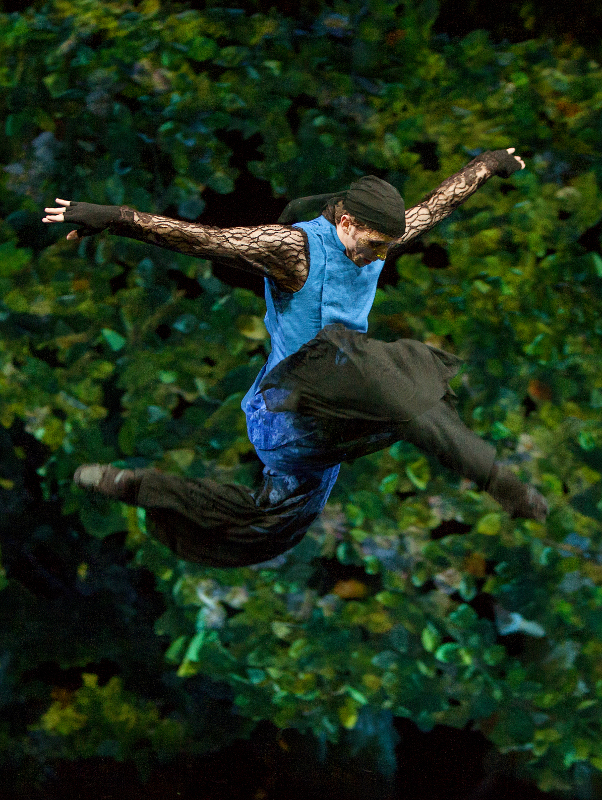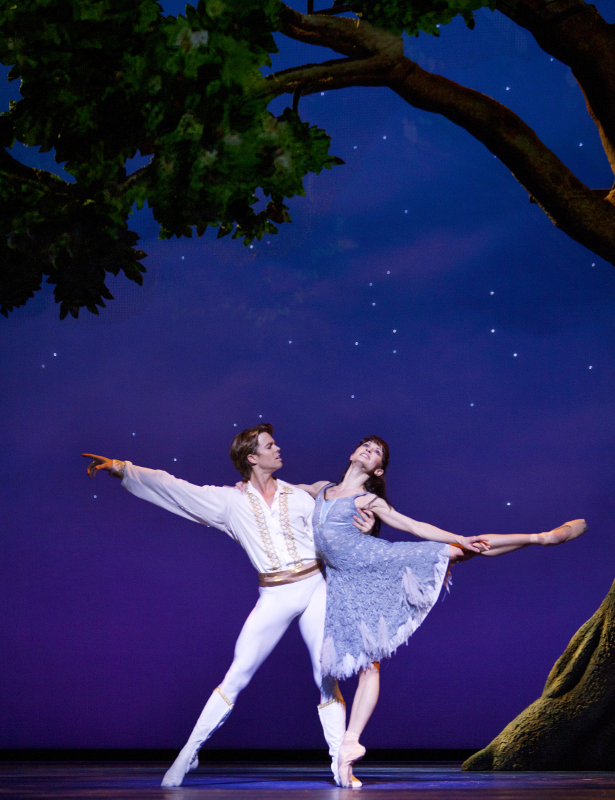Christopher Wheeldon is the purveyor of pretty. You can perfectly well see why San Francisco Ballet, who commissioned a new full-length work from Wheeldon in 2012, got cold feet at the prospect of tackling the difficult, Britten-scored Prince of the Pagodas, and steered Wheeldon instead towards Cinderella, with its ready-made audience of little girls in blue sparkly dresses and splendid Prokofiev score. I'm sure it has been a useful addition to SFB's repertory, and to that of Dutch National Ballet - the co-commissioning company who gave the piece its UK première last night - but I wonder whether a Wheeldon Pagodas might have been an altogether more substantial ballet than the anodyne fairytale we saw at the Coliseum.
As he did in his Alice, Wheeldon has tampered with the story of Cinderella, to give the ash-smutted waif more agency, the handsome prince more backstory, and at least one stepsister the chance of redemption. Instead of a fairy godmother, Cinders (Anna Tsygankova) gets a big tree and four (male) Fates, who look like blue Teenage Mutant Ninja Turtles in palazzo pants (pictured below right). These lurking, spooky helpers might suggest a more Neil Gaiman-esque take on the fairy tale, but Gaiman would presumably have found more interesting things for them to do than moving props, occasionally doing some mopping, and waving the corpse of Cinderella's deceased mamma around in an arm-fluttering exit that has to rank with the worst I have ever seen in ballet. Gaiman, I hope, would also have given Cinderella more interesting virtues than Lightness, Generosity, Mystery and Fluidity - these being the gifts she gets from her arboreal substitute-fairy godmother in the variations usually known as the Seasons (and sympathetically played by the Royal Ballet Sinfonia, who do a fine job throughout). While you can't fault generosity - though, you know, maybe courage or wisdom might have been more fitting in the era of #thisgirlcan - the other three indicate the terrible vapidness of this attempt at a modernised fairy tale. It looks pretty enough, but, much like Sex and the City, as soon as you start to think about the characters, you realise that basically everyone is a bit ghastly.
Gaiman, I hope, would also have given Cinderella more interesting virtues than Lightness, Generosity, Mystery and Fluidity - these being the gifts she gets from her arboreal substitute-fairy godmother in the variations usually known as the Seasons (and sympathetically played by the Royal Ballet Sinfonia, who do a fine job throughout). While you can't fault generosity - though, you know, maybe courage or wisdom might have been more fitting in the era of #thisgirlcan - the other three indicate the terrible vapidness of this attempt at a modernised fairy tale. It looks pretty enough, but, much like Sex and the City, as soon as you start to think about the characters, you realise that basically everyone is a bit ghastly.
Cinders is landed in her menial plight because in a fit of temper she refuses to be nice to her new family, thus enabling her float around the kitchen with a smug odour of burning martyr that understandably irritates the heck out of her stepmother. The prince (Matthew Golding, Tsygankova's real-life husband) appears to be a public schoolboy on a gap yah, horsing around with his buddy Ben (Remi Wörtmeyer) instead of listening to his parents: a repressed, angry father who bristles like an apoplectic colonel when confronted with insubordination, and a glamorous mother who pretends to give a shit about her idiotic son but I bet is secretly browsing Net-a-porter.com and shagging the pool boy (i.e. having more fun than everyone else in this ballet).
The nicest person on stage is Clementine (Nadia Yanowsky), the younger stepsister who, not being beautiful, is actually endowed with the qualities of warmth and open-heartedness that Cinders supposedly has, but which we never really see in action because the beggar she's kind to in Act I is not a poor old woman but a handsome, strapping, flirtatious man - the prince in disguise. I assume this plot innovation is intented to make the main characters seem more like independent actors who can choose their own fate, rather than being subject to an arbitrary coup de foudre later on. But the effect is of course to remove all the magic of the ball scene and ensuing slipper-fitting quest, since the playboy prince has already been to Cinders's house - unless we are to assume that without the ballroom episode he wouldn't have considered marrying Cinders, but would just have just rocked up occasionally in civvies to flirt with a bit of non-Royal skirt. See what I mean about people being ghastly? Of course, a ballet that treats Lightness, Fluidity and Mystery as cardinal virtues comes dressed in luxurious wrappings. Julian Crouch has come up with a few cracking costumes - the quivering pheasant-feather bustles of some beaky tree creatures and the white tulle confections of the corps women in the last scene - and his set designs work well to make it all feel lively: rooms have doors and windows, and the palace has a corridor ingeniously pulled into place by footmen and more-than-usually-animate suits of armour. There is also a splendid coup de théâtre courtesy of Basil Twist, the puppeteer in charge of the tree, who conjures the pumpkin coach out of silk and wind, and plenty of saccharine touches in the Wheeldon style: stars, fireworks, fluttering ribbons that fall from the ceiling. But this is by no means a uniformly gorgeous ballet. As well as the dreadful ninja Fates, we have courtiers dressed in more shiny satin and gold fringe than American junior high majorettes, and the great tree itself is ever-so-slightly grotesque (unlike the similar one in Wheeldon's Winter's Tale), its agitated branches often distracting from the dancing going on in front of it.
Of course, a ballet that treats Lightness, Fluidity and Mystery as cardinal virtues comes dressed in luxurious wrappings. Julian Crouch has come up with a few cracking costumes - the quivering pheasant-feather bustles of some beaky tree creatures and the white tulle confections of the corps women in the last scene - and his set designs work well to make it all feel lively: rooms have doors and windows, and the palace has a corridor ingeniously pulled into place by footmen and more-than-usually-animate suits of armour. There is also a splendid coup de théâtre courtesy of Basil Twist, the puppeteer in charge of the tree, who conjures the pumpkin coach out of silk and wind, and plenty of saccharine touches in the Wheeldon style: stars, fireworks, fluttering ribbons that fall from the ceiling. But this is by no means a uniformly gorgeous ballet. As well as the dreadful ninja Fates, we have courtiers dressed in more shiny satin and gold fringe than American junior high majorettes, and the great tree itself is ever-so-slightly grotesque (unlike the similar one in Wheeldon's Winter's Tale), its agitated branches often distracting from the dancing going on in front of it.
The tree can't take all the blame though: the choreography was frequently less than gripping. Wheeldon can do elegant, interesting, and in fact emotional dance, but little of that talent was in evidence in Cinderella. It boasts a lot of diverting comic and character routines (particular credit to the children, unnamed in the programme, and to the sparky Wörtmeyer), but little that truly delights in either corps de ballet or big solo variations, and in fact some serious awkardness in the pas de deux, where Golding and Tsygankova (pictured above left) frequently fumbled the lifts.
When a husband and wife team of principals both look much better in the character scenes than the big romantic pas de deux, something is wrong somewhere. My explanation would be that romance won't work if your story doesn't have a heart - and for me this tale of shiny happy people getting what they want is lacking precisely that department.
- Dutch National Ballet perform Cinderella at the London Coliseum until 11 July.














Add comment